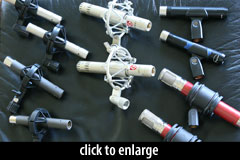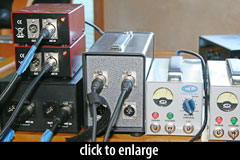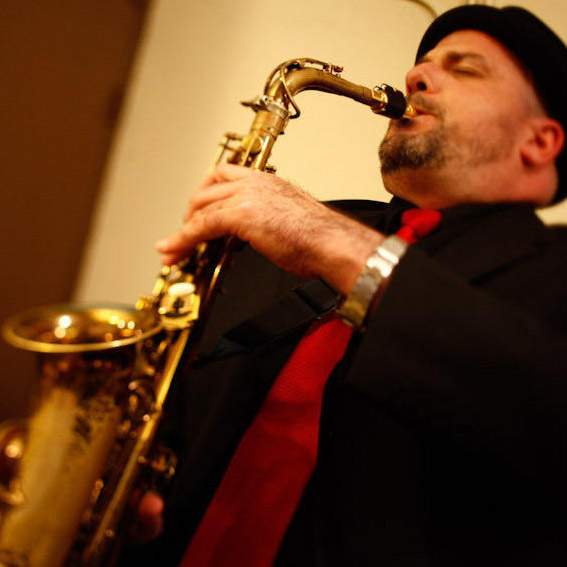
Tube SDCs: the Omni Guitar test
Thursday, September 20th, 2012 | by matthew mcglynn
 By now you’ve no doubt seen Adam Sullivan’s massive Tube SDC Shootout, which covers sax, brass, viola, drums, and acoustic guitar, all tracked with Cardioid capsules. To give you as complete a tour as possible of all these microphones, we brought in a wonderful acoustic guitarist, Maury Manseau, to exercise the Omni capsules that ship with most of these mics.
By now you’ve no doubt seen Adam Sullivan’s massive Tube SDC Shootout, which covers sax, brass, viola, drums, and acoustic guitar, all tracked with Cardioid capsules. To give you as complete a tour as possible of all these microphones, we brought in a wonderful acoustic guitarist, Maury Manseau, to exercise the Omni capsules that ship with most of these mics.
 Avantone Pro CV-28 |
 Chameleon Labs TS-1 Mk II |
 Mojave Audio MA-100 |
 Lauten Audio ST-221 Torch |
 Telefunken Elektroakustik ElaM 260 |
|
| Capsules: | Omni Cardioid, Hyper | Omni, Cardioid, LDC | Omni, Cardioid | Omni, Cardioid | Omni Cardioid, Hyper |
| Street: | $449 | $599 | $795 | $899 | $1495 |
| Mic Clip: | No | No | Yes | Yes | No |
| Shock- mount: |
Yes | Yes | No | Yes | Yes |
For comparison purposes, we’ve included a FET omni, the  Avenson Audio STO-2. This mic uses a miniature electret capsule, and as such is not an ideal match for the other mics here. Alas, it is the only FET omni I had available for this session. (Note to self: add a pair of AKG CK-62 omni capsules to the Ebay wishlist!)
Avenson Audio STO-2. This mic uses a miniature electret capsule, and as such is not an ideal match for the other mics here. Alas, it is the only FET omni I had available for this session. (Note to self: add a pair of AKG CK-62 omni capsules to the Ebay wishlist!)
The Sterling ST44 heard in Adam’s review was left out of this session, because it ships with only a Cardioid capsule. I’ve discovered that this capsule is detachable, and I would be shocked if the Groove Tubes GT44 Omni capsule didn’t work on this mic. But I don’t have any of those capsules here, yet.
Test Setup
 We tracked Maury’s guitar in mono, at two distances. Omni capsules have no proximity effect, which means we can get close to the instrument without excessive bass buildup. Based on listening tests, we put one mic approximately five inches from the guitar’s neck/body junction, and a second mic about 19 inches out.
We tracked Maury’s guitar in mono, at two distances. Omni capsules have no proximity effect, which means we can get close to the instrument without excessive bass buildup. Based on listening tests, we put one mic approximately five inches from the guitar’s neck/body junction, and a second mic about 19 inches out.
All the tube mics were allowed to warm up for at least 15 minutes prior to tracking. All were routed through the preamps in a BLA-modded Digi 002 Rack, and converted at 24 bit, 44.1 kHz.
In most cases, the ‘near’ and ‘far’ tracks for a single brand/model of mic were tracked simultaneously. The Avantone mic was an exception; we used a single mic, moving it between takes.
The resulting tracks were exported as full-resolution WAVs, then RMS gain-matched in Sample Manager (a neat batch audio processing app we’re testing). Below are 320kbps mono MP3s.
Audio Samples – “Near” placement
Listening Notes – “Near” placement
 In a blind test, the first thing that struck me was that all the near tracks sounded good. Everything that follows describes subtle differences.
In a blind test, the first thing that struck me was that all the near tracks sounded good. Everything that follows describes subtle differences.
Over repeated listens, a few distinctions jumped out. One is the noise floor of the Avenson Audio STO-2. As a miniature electret, it has much higher self-noise than any of the other mics here. I didn’t notice it through nearfields, but it was immediately obvious through headphones. Still, this mic turned in an authoritative track. I found it to be more neutral in tone than some of the other mics, which isn’t surprising considering its flat-line frequency curve. This mic seemed better able to resolve individual strings within chords than any of the other mics too. But I did miss the low-mid warmth that the rest of the mics delivered.
My favorite mics in this test changed as I listened more. In the end — and I’ll repeat that I’m splitting hairs on some of these — I lean toward the Mojave MA-100 and the Telefunken ElaM 260. Tonally, these two mics are different; the MA-100 has more happening in the mids, while the ElaM 260 has a boost above 8kHz. The MA-100 is smoother, while the Telefunken is more articulate. Both sound fantastic.
The Avantone CV-28 is right in there, though. Tonally, it is very close to the Telefunken. I think the Teles capture a bit more definition. But the CV-28 sounds great here.
The Chameleon Labs TS-1 is also pretty close to the Telefunken in terms of tone and frequency response. If anything, I think the TS-1 manages to capture even more of the steel in the strings. There’s a subtle weight to each pluck that I find totally compelling; I can feel the pick leave each individual string.
The Lauten Torch captured the smoothest, warmest track of the lineup. It has the same mid-forward tone as the Mojave, but a bit less sparkle on top. On this guitar, I’d be tempted to boost the highs on the Torch to bring out some of that high-end articulation I’m missing.
The bottom line is that all these mics sounded great in Omni on this acoustic guitar. I wouldn’t turn down to the opportunity to use any of them.
Audio Samples – “Far” placement
Listening Notes – “Far” Placement
If you’ve been listening to the “near” tracks, the “far” tracks will sound overly roomy and distant. Initially, I didn’t like any of them, and got to thinking that if you’re going to put a mic that far away from an acoustic guitar, it ought to be Cardioid.
After letting my ears acclimate to the space, I realized that all my earlier observations (and Adam’s too, for that matter) held up pretty well. Taking the STO-2 as a neutral reference, the Telefunken mics sounded more polished, maybe just slightly hyped on top. Call it “sparkly in a good way.” The Mojaves have more midrange girth and authority, with some air to give the strings definition.
The Avantones reach deeper than any of the other mics here. The lows are huge! Listen to the strummed section a few times in a row, and the other tracks will sound high-passed. I’m not sure that low end is real, but I dig it. I wouldn’t usually need all that low end on an acoustic guitar, but it’s easier to take it away than put it in artificially.
The Chameleon‘s Omni capsule retains the articulation of the Cardioid; there’s almost a percussive quality to the strumming. If you want to bring out the rhythm of the acoustic guitar track, this is your mic.
The Lauten sounds more balanced at this distance than up close; the lows are reduced — actually that’s true of most of these mics — and the mids are brought forward. I hear more highs on this track than up close, as well. The smoothness of the earlier track is still here; compare the strummed section to the Chameleon, which sounds like it was played with a much heavier pick. (To be clear, the same pick was used throughout.) But overall, I prefer this mic for adding weight to the finger-picked section. It would also be great for adding body (or reducing splash) from a smaller guitar.
I think the Avensons have better transient response than any of the tube mics. They should, of course, due both to the smaller diaphragm and to the transformerless solid-state circuitry. But it’s a nice sanity check to hear this effect in action.
Speaking of sanity checks — after listening to these for hours and writing the section above, I set up a fresh blind listening test. Based on my earlier listening notes, I was able to correctly identify all six tracks. And yet, during that very first pass, my initial panicky reaction was, uh-oh, they all sound the same! A casual listen over compromised monitors will not reveal many distinctions. These are subtle differences in articulation and tone. “Subtle” does not mean “negligible,” but it does mean you’ll need to listen carefully.
Conclusions
If I had to pick favorites, I have to say it would depend on the source and the production. Just like, you know, always.
Each of these mics brings something subtly different to the session. For example, I love the shimmer of the Telefunkens. It’s not neutral, but it sounds great. Then the Mojaves have a mysterious inky blackness behind the notes, some sense of space that gives the track a deeper third dimension. Call it Dave Royer’s tube magic. The Avantone really brings out the bottom, at least in the distant placement test; as the least expensive mic in this lineup, it represents a good bargain.
The Lauten is invariably smooth and tends toward dark, to my ear; I bet I’d love this mic on guitar cab or drum room… like Adam suggested, basically the same places you’d put a ribbon. And the Chameleons seem from this session almost like a “tube lite” sound, retaining the transients and articulation of a clean FET mic, but with an undeniable depth and warmth that my FET sample doesn’t capture. It’s a great hybrid sound.
(On that note, I should point out that the  Mk II version of the TS-1 has a variable tube heater control, so, theoretically, it should be possible to dial up the heat, literally. I’m hoping to have the opportunity to do a fuller evaluation of this little mic soon.)
Mk II version of the TS-1 has a variable tube heater control, so, theoretically, it should be possible to dial up the heat, literally. I’m hoping to have the opportunity to do a fuller evaluation of this little mic soon.)
Thanks
Special thanks to Maury Manseau for enduring many mic changes for the purpose of this mic comparison.
Also, I thank the kind folks at Mojave, Avantone Pro, Lauten Audio, Telefunken Elektroakustik, and Chameleon Labs for the use of their fabulous microphones.
This is the second of a 3-part review of contemporary small-diaphragm tube condenser microphones:
- Massive Tube SDC Review
- Omni Tube SDCs on Acoustic Guitar (you are here)
- Tube Mic Drum Overhead Shootout
Tags: Maury Manseau
Posted in Microphones, Reviews, Shootouts | 5 Comments »



Adam Sullivan
September 20th, 2012 at 11:16 am
Matt, your comment about the Chameleons being a bit more “tube lite” is pretty much in-line with the experiences I’ve had with the TS-2 (large diaphragm tube condenser), which I’ve owned for a few years now: it’s got some of that depth that you’d expect from tubes, but the transients are a little faster than you’d expect. In fact for my money you have to watch out for sibilance a little more than I’d prefer when tracking vocalists. Tape on that pencil!
I actually found it a little TOO easy to get things past warm and into overdrive with that heater control, and have since modified that mic by swapping out the included 12AX7 tube for a lower gain 12AU7, which made the heater control a good bit more nuanced and useable.
Big Dave
September 22nd, 2012 at 5:53 am
It is interesting that the properties that I didn’t like on the near mic I liked on the distant mic. that is weird. I will be referencing back to this shootout as I record my guitars.
Graham Spice
September 26th, 2012 at 9:03 am
The Mojave MA-100 is my fav acoustic guitar mic in the closet. We don’t have that fancy Telefunken but would love to try it out. In my experience, each of the Mojave mics in their line continues to be an outstanding value.
Thanks for posting this shootout
Steve Hickman
October 1st, 2012 at 9:18 am
I did the same on this test as I did with Adam’s review: I picked my top 3 at both distances. This time it was:
Near: 1. Lauten 2. Mojave 3. Avenson
Far: 1. Avantone 2. Telefunken 3. Mojave
These comparisons are always very informative. Thanks again Matt for doing what most of the rest of us can’t afford to do.
Joel
October 20th, 2012 at 2:54 pm
This was the only test out of all of the Tube SDC tests where I actually picked the Telefunken as my first choice! Close second was the Chameleon (Im getting good at picking it out!).
I gotta say that this test threw me off in my guesses, the characteristics I was hearing in each mic for other instruments we’re almost always completely different in this particular test… Weird!
Gotta say though, the Chameleons are probably going to end up in my collection in the next year.